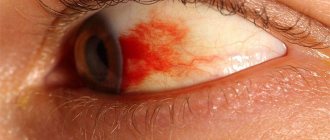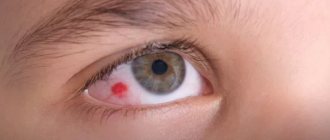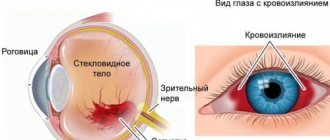Hemorrhage under the conjunctiva or subconjunctival hemorrhage is a condition when, due to a number of reasons, a blood vessel bursts and blood flows into the space between the conjunctiva of the eye and the sclera (the white, dense lining of the eyeball). In turn, the conjunctiva is a thin, transparent mucous tissue that, in the form of a shell, covers the entire back surface of the eyelids and the front surface of the eyeball, rich in small and fragile blood vessels. It ends at the limbus of the cornea.
Classification of subconjunctival hemorrhage
In essence, this disorder is an ordinary bruise that goes away on its own within 10-12 days.
However, it does not affect visual acuity and does not cause abnormal changes in the structure of the eye. In addition to subconjunctival, there is the following classification of hemorrhages:
- Hyposphagma.
This bleeding is caused by damage to the blood vessels of the mucous membranes. In this case, blood flows out under the conjunctiva. It itself includes many small vessels that are considered very fragile. When they are damaged, blood enters the area between the tunica albuginea and the conjunctiva. - Hyphema.
This effusion provokes damage to the anterior chamber of the eye. It is caused by a violation of the integrity of the vessels of the iris or ciliary body. The greatest danger is corneal hemorrhage. In this case, discomfort and fog appear before the eyes. In such a situation, you should immediately consult a doctor. - Hemophthalmos.
This term refers to hemorrhage into the vitreous body, which is located in the structure of the eye. This violation is very dangerous and is accompanied by the appearance of fog. Sometimes it can cause complete loss of visual function. A violation can provoke problems with refractive vision, the occurrence of visual effects, and destruction of the vitreous body. - Retinal hemorrhage.
In this case, blood flows into the retina, which is located on the back wall of the eye. The violation poses a real danger as it can cause serious loss of visual function. However, it remains asymptomatic for a long time. Only fundus ophthalmoscopy will help identify the problem.
Prevention
There are primary and secondary measures to prevent subconjunctival hemorrhage. In the first case, these are measures for healthy people to reduce the risk of pathology. These include:
- Hardening.
- Walk outdoors.
- Filling your diet with vitamins and beneficial microelements.
- Control of water balance.
- Taking vitamins.
Secondary prevention measures are recommended for people with frequent bleeding and for those who are at risk. They should take a responsible approach to the treatment of diseases that lead to fragility and thinning of blood vessels. You also need to monitor your blood pressure. In addition, you should stop taking anticoagulants if these drugs are the cause of hemorrhages. You should not delay contacting a doctor if hemorrhages are observed frequently and are accompanied by pain or other symptoms indicating the possible development of any pathologies.
Causes of subconjunctival hemorrhage
Subconjunctival hemorrhage of the eye can be due to various reasons.
Mechanical factors include the following:
- Direct eye injury.
The cause of the problem is a blow or damage from some object. - Indirect damage.
This category includes combined injuries - for example, fractures of the temporal or frontal bone, which cause damage to the eye. - Increased pressure in blood vessels.
The problem is caused by fluctuations in blood pressure. They are also caused by a sharp increase in venous pressure, which is observed with a strong cough. In addition, provoking factors include intense physical activity, bouts of laughter, constant crying in children, and vomiting. - Carrying out surgical interventions on the eyeball.
In this case, postoperative subconjunctival hemorrhage develops.
A common cause of problems is age-related processes in blood vessels. This category includes thinning of the walls of blood vessels and atherosclerotic damage to the capillaries. Also the cause is the development of diabetes mellitus, which makes blood vessels more fragile.
A common cause of the disorder is problems associated with blood clotting. This category includes hereditary pathologies - primarily hemophilia. Since subconjunctival hemorrhage may be a symptom of a congenital disease, it is worth conducting a detailed examination. First of all, this is relevant for children. Acquired forms of the disorder can be provoked by a long course of use of anticoagulants.
What is hyposphagma?
When one of the blood vessels in the conjunctiva ruptures, the tissue fills with blood, causing what in ophthalmology we call subconjunctival hemorrhage or hyposphagm. Because the conjunctiva cannot quickly reabsorb blood, the fluid becomes concentrated and the white of the eye turns bright red.
Subconjunctival hemorrhage can occur without damaging the structure of the eye. The blood vessel can easily rupture during a coughing or sneezing attack.
Symptoms of subconjunctival hemorrhage
It is not difficult to identify the symptoms of subconjunctival hemorrhage yourself. To do this, just look in the mirror. With this disorder, a red spot appears on the white part of the eye. In this case, there is no pain or deterioration in visual functions. The pathology is confluent in nature. This is what distinguishes it from other types of redness of the organ of vision. Despite the threatening clinical picture, this type of hemorrhage is not dangerous and does not affect visual functions.
Diagnosis of subconjunctival hemorrhage
To diagnose subconjunctival hemorrhage, it is necessary to perform a general examination.
People who are frightened by their appearance usually immediately consult a doctor. Constant exacerbations of pathology indicate vascular damage or the development of diseases of the circulatory system. In such a situation, a detailed examination is required. It should include the following studies:
- general blood test
- this requires a detailed study of the content of red blood cells, platelets, hemoglobin; - general urine test
- it is necessary to determine the presence of red blood cells; - biochemical study
- this evaluates the parameters of cholesterol and lipoproteins of different densities, which are direct criteria for atherosclerotic vascular damage; - coagulogram
– allows you to evaluate the detailed concentration of blood clotting factors; - Holter monitoring
- is a daily monitoring of pressure, which allows you to eliminate its changes during the day; - Ultrasound of internal organs
- monitoring the condition of the liver and spleen is of no small importance.
Treatment of subconjunctival hemorrhage
Specific treatment for subconjunctival hemorrhage is not required. Within 1-2 weeks, the blood stain resolves on its own. To stimulate this process, you can use potassium iodide drops with a concentration of 3% and methylethylpyridinol preparations 1%. However, the main therapy is aimed at eliminating the pathology that provoked the hemorrhage.
If discomfort and pain appear in the eyes, the doctor may prescribe special drops that have anti-inflammatory properties and help cope with swelling. Antibacterial agents are used to prevent infection.
With this type of hemorrhage, it is strictly forbidden to wear contact lenses. It is recommended to replace them with glasses during the period of therapy. In addition, it is forbidden to rub your eyes or use drops without a doctor’s prescription.
Why does a blood vessel burst in the eye?
If a vessel in the eye bursts in a person, the reasons can be completely different: from overwork and increased stress on the eyes to eye injuries and fractures of the bones that form the vaults of the skull.
It is impossible to accurately identify the cause of the pathology at home, since one of the main diagnostic measures for hemorrhages is measuring intraocular pressure.
Subconjunctival bleeding (medically called hyposphagma of the eye) occurs as a result of damage to the capillaries located in the mucous membrane covering the space between the edges of the eyelids and the eyeball.
The main function of the ocular conjunctiva is the secretion of liquid and mucous components of the tear fluid necessary to moisturize the eye, therefore one of the symptoms of the pathology is “bloody tear” - the release of tears mixed with blood or blood streaks.
Doctors consider the following factors and conditions to be the main causes of hemorrhage in the eye:
- chronic hypertension leading to increased intraocular pressure;
- diseases of the respiratory system, accompanied by paroxysmal dry cough (pulmonary tuberculosis, bronchitis, pneumonia, whooping cough);
- immunopathological, acquired and congenital bleeding disorders (coagulopathy);
- hemorrhagic inflammation of the ocular conjunctiva, provoked by enterovirus infection;
- infection with Leptospira spiral bacillus;
- surgical treatment using an excimer laser (LASIK correction).
Increased intraocular pressure and damage to capillaries can be caused by increased physical activity, heavy lifting, and chronic constipation. Infectious diseases accompanied by acute intoxication and vomiting can also cause sudden eye bleeding.
In order not to get confused in such a situation and be able to provide the victim with the necessary help, it is important to know why capillaries burst in the eyes and what to do if signs of pathology appear.
Reasons for women
In women, subconjunctival hemorrhage can be a consequence of certain gynecological diseases, for example, inflammation of the uterus (endometritis) and pathological proliferation of the mucous membrane of the uterine walls, in which endometrial tissue extends beyond the uterine cavity (endometriosis).
Pushing during childbirth can cause damage to the blood vessels of the eye, especially if a woman does not follow the recommendations of doctors and midwives and concentrates pushing efforts on the muscles of the face rather than the abdomen.
Causes in infants
Many mothers are frightened when they see signs of eye bleeding in their newborn children, because they do not know what causes the vessel in the baby’s eye to burst.
The pathology in 80% of cases occurs during difficult labor, which requires the use of a vacuum aspirator or the application of obstetric forceps. Injuries received during passage through the mother's birth canal contribute to an increase in intracranial and intraocular pressure and injury to blood vessels, so immediately after birth the child may experience signs of a “bloody eye” - a symptom complex of subconjunctival bleeding.
Hypophagma of the eye in children in the first months of life can also occur against the background of a deficiency of vital vitamins and elements responsible for the strength and elasticity of the vascular walls: ascorbic acid, vitamins E, A and K.
Complications of subconjunctival hemorrhage
This type of hemorrhage is considered the safest and does not require special measures to eliminate it.
In this case, the frequent occurrence of a disorder is the basis for a detailed diagnosis. Symptoms of complications of subconjunctival hemorrhage include the following:
- damage to both eyes at the same time;
- traumatic eye injury;
- serious problems with refraction of vision or its complete loss;
- pain;
- the appearance of fog before the eyes.
Reasons for visiting a doctor
In some cases, when subconjunctival hemorrhage occurs, the patient may need medical assistance:
- decreased visual acuity and quality;
- sensation of the presence of a foreign body in the eye;
- the presence of a purplish-blue tumor on the eyelids, acquiring a yellowish color as it decreases;
- the appearance of light flashes or floating spots before the eyes.
Increased lacrimation, pain in the eyes, which appears as a result of trauma to the organs of vision or cranial trauma and does not disappear within several days, are also reasons to contact a specialist.











